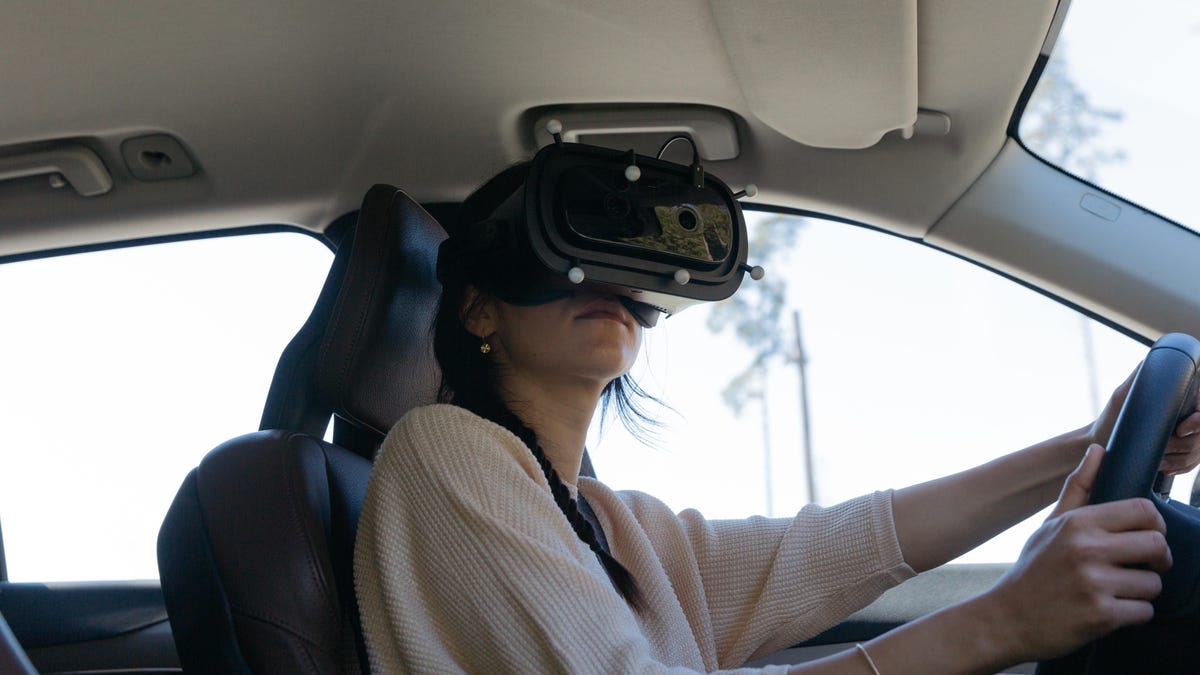Varjo XR-1 is an AR headset so fast, Volvo test drives cars while wearing it
The new mixed-reality headset promises perfect retina resolution and no perceivable lag. It arrives later this year for an unknown price.

Test driving with the XR-1 on is actually possible: Volvo is doing it.
I see a car driving down a test track. The dashboard is real. But now it's a glowing blue skeletal frame. The dashboard has changed. It's become virtual. The car is still racing. Real car, real driving, virtual interface.
Welcome to Varjo VR-1.
Earlier this year, I wore the Varjo and it was the highest-resolution VR headset I've ever experienced. That $6,000 eye-tracking headset, designed for retina-perfect renderings of designs and 3D models, was designed to eventually upgrade to a mixed-reality model, adding pass-through camera capabilities to fold in the real world and blend it with VR. Varjo's XR-1, coming later this year, is that upgrade. Unfortunately, I haven't had a chance to try the XR-1 yet. Instead, I'm watching the demo video of what the XR-1 can do as I talk to Varjo's founders about the XR-1's capabilities.
Unlike a Microsoft HoloLens or Magic Leap, which seem to project holographic objects on top of the real world, the Varjo XR-1 is a mixed reality headset that uses dual 12-megapixel outer cameras to pass video of the outside world into VR. Varjo aims to do it with the same crazy-high resolution of its VR headset, and at a latency so low that you can drive a car while wearing it. Literally. That's what Volvo is already doing.
The XR-1 is built off similar hardware as the VR-1 headset, but with the added passthrough cameras and significant internal optimization that effectively make it a whole new product (Varjo is working on a way for customers who already bought the VR-1 to upgrade when it launches later this year). But unlike the VR-1, the XR-1 is more of a developer's kit, according to Varjo's Finnish founders. There are no apps yet. There's no announced price yet, either (expect it to be... high). But the target market is companies like Volvo. Volvo, now an investor in Varjo through its Volvo Cars Tech Fund, is the first company that's designed for the XR-1, and it's being used in actual test track driving, with a real purpose: Volvo's using it to test interfaces for future cars.
"Instead of the usual static way of evaluating new products and ideas, we can test concepts on the road immediately," Henrik Green, Volvo's CTO, said in a press release from Volvo about the company's decision to use this technology. "There hasn't been any hardware on the market that could make this possible," Casper Wickman, Volvo's Technical Leader, said to CNET.
A look through a laptop at what the driver sees in mixed reality in the Varjo XR-1.
Volvo has been experimenting with mixed reality for years, and used Microsoft HoloLens to help design cars back in 2016. But what's being done with the Varjo XR-1 is a far different story. The pass-through cameras and the headset's ability to mix camera input with virtual renderings happen at a speed that Varjo says is so low-latency that it won't be perceived. 12 milliseconds, roughly. For Volvo, that latency is low enough that it won't compromise safety when test driving actual cars. Varjo's headset resolution also aims for an experience that will feel so real that it won't seem pixelated or virtual at all.
The XR-1 is being used by Volvo to specifically model and test heads-up displays and new interfaces. If Volvo has a new dashboard readout, it can be test-driven in a car using the Varjo XR-1, while eye tracking studies how distracting or helpful the interface can be. The headset's already been used at Volvo's research facilities in Sweden, and it could help the company begin to safety-test new interior concepts well ahead of a physical design even existing. Volvo's also experimenting with adding virtual obstacles while driving on actual tracks (other cars, or maybe a virtual moose that appears on the road, for instance) to add realism.
To be clear, this isn't a mixed reality headset intended to be worn anywhere other than a contained testing environment. But it's a stunning first-use case for a mixed-reality headset: While most other AR devices are still aspiring to be fast and accurate enough to work in mission-critical situations, Volvo already believes Varjo's solution passes the test for its safety-testing needs.
From here, Varjo aims for applications like flight simulators (imagine cockpits that blend real and virtual), and eventually medical training applications. I haven't had a chance to try the XR-1 yet, but it sounds like the fastest mixed-reality headset in existence. And maybe it could maybe help make cars safer, too.

